Assortment of tomatoes "Königsberg": description of varieties and tips for effective cultivation
Tomatoes are a thermophilic crop. Therefore, many residents of the Urals and Siberia face difficulties in obtaining a decent harvest of tasty and healthy fruits. Salvation for them is greenhouses and cold-resistant varieties of tomatoes. One of these varieties is Königsberg. In addition to cold, tomatoes tolerate hot weather and drought well. Read about other advantages and rules for growing Königsberg tomatoes in our article.
The content of the article
Characteristics and description of the variety
The tomato was bred by vegetable grower Vladimir Dederko. In 2005, the variety was registered in the State Register of the Russian Federation. The description indicates that the variety was acclimatized in Western Siberia and is intended for open field cultivation. However, an ovary appears in greenhouse conditions.
Subspecies of the Koenigsberg variety
Today, several subspecies of the Siberian Konigsberg have been bred:
- red;
- gold;
- cordate;
- new;
- striped;
- pink.
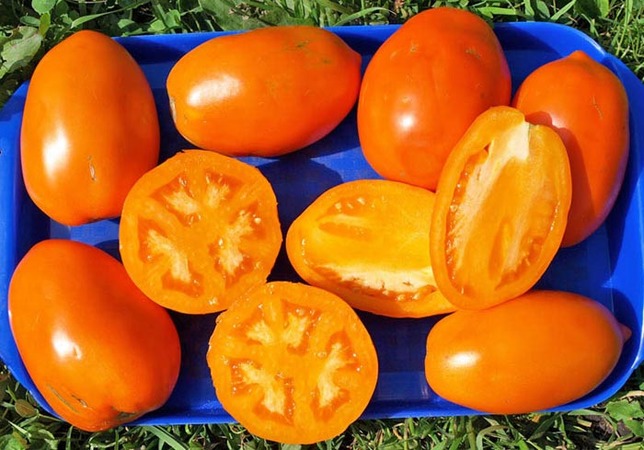
Red- the main subspecies, many of its characteristics are inherent in the rest. Grown in greenhouses and open beds. Plant height reaches 180-200 cm. The shape of the fruit is oblong, the color is bright red. Ripening occurs in mid-July-early August. Tomatoes are stored for a long time. The subspecies is called the most resistant to cold - it can withstand a drop in temperature to 0 ° C.
Gold- differs from red in yellow skin color and high sugar content. With a lower yield, the subspecies is less susceptible to fungal diseases.
Cordate- bushes grow up to 2-2.5 meters. The shape, as the name implies, is heart-shaped. Subspecies with the largest fruits (up to 1 kg).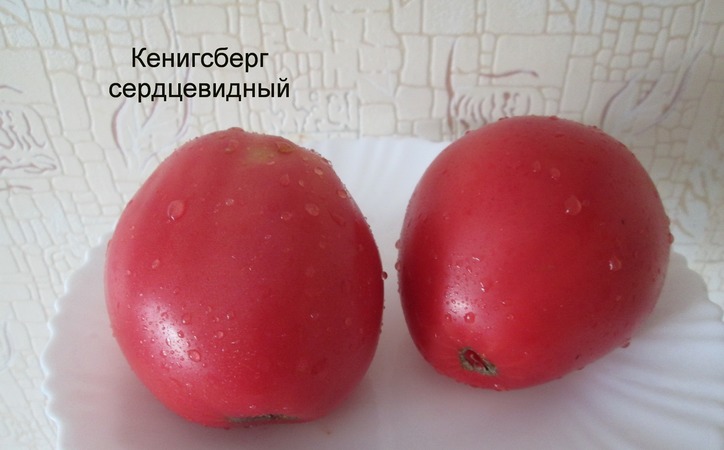
New Konigsberg - mid-early, red fruit, the most productive subspecies.
Striped- red oblong fruit with yellow-orange stripes. Tomatoes are small, weighing up to 300 g.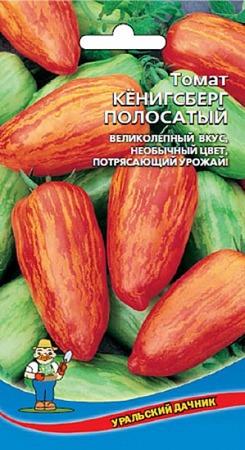
Pink- differ in color and light weight - up to 200 g. The yield of the subspecies increases when growing tomatoes in a greenhouse.
Distinctive features
Indeterminate variety, bush height - 2 m. Mid-season - the first tomatoes are harvested 110-115 days after germination.
Powerful root system, large dark green leaves with a light down. Up to 6 inflorescences are formed on each brush.
Fruit characteristics, yield
The shape of all subspecies, except for the heart-shaped one, is a cylinder with a pointed tip. The color depends on the subspecies: red, yellow, pink, striped.
The average fruit weight is 230 g, however, at the bottom, larger tomatoes weighing up to 900 g are formed, at the top - 150-300 g.
Other characteristics of the fruit:
- thick, shiny skin;
- fleshy, sweet and aromatic pulp;
- seed chambers 3-4, in one tomato up to 50 grains.
5 to 20 kg of tomatoes are harvested from 1 square meter. The yield depends on the subspecies, weather conditions and care.
How to grow seedlings
Seeds for seedlings are sown in early March in central Russia, in the northern regions, no later than early April, otherwise the fruits will not have time to ripen.
Seed preparation
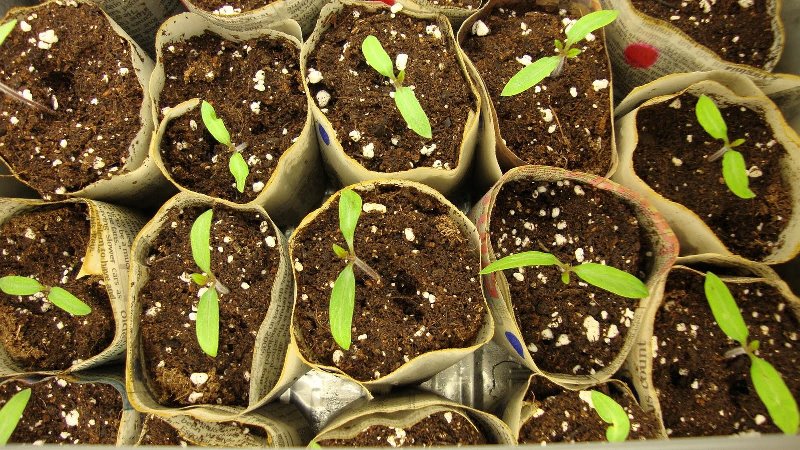
Planting material is prepared in 7 stages.
- Selection of viable grains. Choose large and medium-sized seeds that are even and not empty to the touch. They are placed in a saline solution (200 g of water 1 tbsp. L. Salt) for 15-20 minutes. The seeds that have sunk to the bottom of the glass are taken for planting.
- Warming up... The seeds are laid out on a cotton cloth and placed on a central heating battery for 1.5-2 days.
- Disinfection... Seeds are treated with 1% potassium permanganate solution. For its preparation, 1 tsp is dissolved in 600 g of water. (without a slide) crystals of potassium permanganate. After 15-20 minutes. the seeds are taken out of the solution and washed with running water.
- Bubbling... The grains are placed in warm (+ 26-30 ° C) water and stirred every hour for 15-18 hours. Some summer residents use an aquarium compressor. Oxygenation increases seed germination and improves the vitality of future seedlings.
- Soak... The planting material is immersed in warm water or a solution of biostimulating drugs. Summer residents recommend using "Zircon", "Epin", "Sodium humate", "Energen" (in liquid form). The duration of the procedure is 12 hours. Some gardeners advise to try "honey soaking": dissolve a teaspoon of honey in a glass of cool water. The seeds are placed on a cloth or gauze, 3-5 tablespoons of the solution are poured and the cloth is wrapped in an envelope. The duration of the procedure is 3-12 hours, as the tissue dries, it is moistened with a solution.
- Hardening... The seeds are wrapped in cotton cloth and plastic wrap and placed for 8 hours in a cool place (around 0 ° C), for example, a refrigerator or balcony. The seeds are taken out for 8 hours at room temperature. The procedure is repeated 5-6 times. Experienced farmers do not harden all planting material - there is a high risk of destroying the seeds if the procedure is performed incorrectly.
- Germination... The seeds are wrapped in cotton or gauze and placed on a flat dish (saucer, Petri dish, lid). The fabric is constantly moistened with warm (+ 25-30 ° C) water until embryos of 2-3 mm in size appear.
Capacity and soil
Tomatoes are planted in plastic containers, cups, cut bottles.
The soil mixture is bought in the store, they are taken universal for tomatoes. Its composition:
- humus;
- peat;
- river sand.
The earth is prepared independently from:
- garden land - 1 part;
- non-acidic peat - 2 parts;
- sand - 0.5 parts;
- humus or sifted mature compost - 1 part.
It is recommended to add wood ash or dolomite flour, sphagnum moss and fallen needles to the mixture.
The soil and containers are treated with boiling water or a solution of potassium permanganate.
Sowing
The soil mixture is laid out in containers. Seeds are placed on top, which are covered with a centimeter layer of soil. Spray with water, cover the cups with foil and put them in a warm, bright place.
Important! Fragile seedlings are protected from direct sunlight.
Growing and care
The first shoots appear on day 4-5. The film is removed. Pour at the root with a spoon or syringe so as not to wash out weak roots.
At the age of 10-14 days, when 2 true leaves appear on the sprout, the seedlings are dived into individual containers. Mineral fertilizers are applied to the new soil at the rate of 1 tbsp. l. 5 liters of soil. Seedlings are added dropwise to the cotyledon leaves. 10 days after picking the seedlings fed with complex fertilizer... Top dressing is repeated every 2 weeks.
Water at the root as it dries, being careful not to wet the leaves. 2 weeks before moving to the garden, they begin to harden the seedlings. It is taken out into the open air (balcony, summer veranda or gazebo) for 2-3 hours. Before moving, the seedlings are left in the open air overnight. Hardening helps the seedlings to adapt to low temperatures and sunlight.
Important! Summer residents note that the peculiarity of Konigsberg is the external lifelessness and lethargy of seedlings - you should not be afraid of this.
How to grow tomatoes
They are transplanted into a greenhouse at the age of 50 days, in open ground - 60 days. During this time, the seedlings grow up to 25 cm.
Landing
For tomatoes, they choose a site where cucumbers, zucchini, dill grew last season, so as not to violate the rules of crop rotation. Vegetables of the nightshade family will become unfavorable predecessors and neighbors.
The soil for Konigsberg is prepared in advance.Fertilize in autumn: 1 sq. m make a bucket of humus, 40 g of superphosphate, 500 ml of wood ash. The day before transplanting, the earth is spilled with boiling water or a solution of potassium permanganate.
For 1 sq. m are planted with 3 bushes. Choose from two schemes:
- Staggered in 2 rows. Distance between plants 60 cm, between rows 70-80 cm.
- Parallel, 2-lane... The distance between plants is 60-70 cm, the tapes themselves are placed every 90-100 cm from each other.
Care
Strong roots allow plants to easily cope with a lack of moisture, and an excess is harmful. Therefore, tomatoes are watered abundantly, but not often, by the root method, avoiding water getting on the stem and leaves. With each watering, weeds are removed and the soil is loosened to provide oxygen to the rhizome.
Fertilizers are applied every 2 weeks, alternating complex and mineral fertilizing.
Tomatoes are formed into one or two stems. Stepchildren over 3 cm long are removed every 2 weeks.
The bushes are tied to supports immediately after planting seedlings in the beds.
Features of cultivation and possible difficulties
Gardeners gradually remove the lower leaves, and after the formation of the seventh brush, pinch the top of the bush.
After the formation of the first tomatoes, pinching is stopped.
Tomatoes have difficulties with self-pollination, so in greenhouses, farmers manually pollinate the inflorescences with a brush, and in open beds they gently shake the bushes for this. If the tomatoes are not helped, little ovaries are formed, which means the yield will decrease.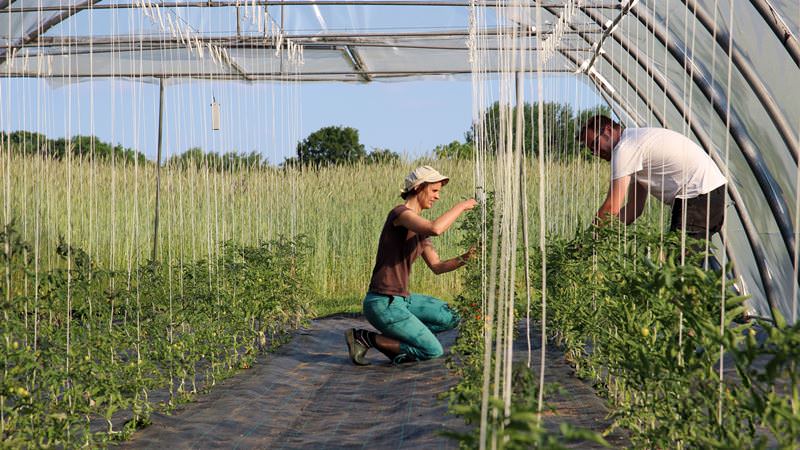
Diseases and pests
Königsberg has high immunity against common tomato diseases. However, for the prevention of phytosporosis, tomatoes are treated with special preparations:
- "Fitosporin".
- Ecosilom.
- "Quadris".
- Ridomil Gold.
Summer residents noted that due to a lack of potassium in the soil, in greenhouses, fruits are affected by apical rot. To avoid this, each hole is filled with ash during planting (1 liter per bush).
Harmful insects do not attack a tomato. But if this happens, the plantings are treated with special preparations. "Zubr" will help from aphids and thrips, from the Colorado potato beetle - "Prestige", from whitefly - "Confidor".
The nuances of growing in open ground and in a greenhouse
Agricultural technology in a greenhouse and in open beds is no different. Farmers note that in greenhouse conditions, with the same care, tomatoes bear fruit longer.
Read also:
How to get rid of scoops on tomatoes once and for all?
Harvesting and application of the crop
The first fruits are harvested at 110-115 days. They are eaten fresh, canned sauces, lecho and other snacks. For making juice - not the best variety, there are more juicy tomatoes.
They are also not suitable for pickling in a whole-fruited form - too large tomatoes do not fit into the jar. Tomatoes are suitable for long-term storage and transportation.
Advantages and disadvantages of the variety
The advantages of Koenigsberg include:
- yield;
- taste, color and shape of the fruit;
- resistance to weather changes, drought, cold, heat;
- the possibility of growing in the open field;
- immunity to disease.
The minuses of the variety are mid-ripeness, the need tie up constantly and pinch bushes, reducing yields under adverse conditions.
Farmers reviews
A review of opinions about Königsberg tomatoes speaks of the high quality of the variety: gardeners like their taste, variety of shapes and colors, yield and resistance to diseases.
Alla Zmeeva, Moscow region: “I have been planting the Zolotoy Königsberg tomato variety for a long time. I plant it a lot and constantly. This variety succeeds both outdoors and indoors. In the open field, the plant does not grow so high, but it still needs to be tied to stakes, and the tomatoes themselves are smaller. This circumstance does not affect either the quality of the crop or the quantity. A very productive variety. Resistant to late blight ”.
Dmitry Bruev, Tomsk: “Konigsberg disappointed me this year. The first brushes were badly tied on the bush. They have two or three tomatoes on them. He threw out the second brushes very high - and even there are three pieces tied there. But for me, perhaps, the reason is that this year the seeds are my own, collected. When I planted with seeds from Biotechnics - there was a fairy tale what kind of tomatoes! They were one of the last to ripen, fleshy, sweet, a lot on the bush! I fell in love with this variety. "
Elena Stroeva, Tambov: “We have been growing Konigsberg Krasny at our dacha for five years already. We always plant seedlings in open ground, since there is simply no greenhouse. We grow the seedlings ourselves, it really looks frail and fragile, the stems of the tomatoes are thin, the leaves are sluggish. But after planting in the ground, everything changes dramatically: tomatoes grow quickly, the leaves become large and fleshy. This variety is grown in one stem, but two plants are soot in each hole. I pinch all the ovaries except the first 6-7. Here, in Tambov, Koenigsberg has time to mature on a bush. The tomato has never been sick with anything, although I have not processed it. Next year I will definitely buy the seeds of the Golden Konigsberg, they say its fruits are even tastier and last longer. "
Conclusion
Königsberg tomatoes are suitable for growing outdoors and greenhouses. Its advantage over other varieties is its resistance to cold, hot and dry weather, which allows it to be harvested in all regions of Russia. Gardeners love tomatoes for their taste, a large selection of colors, shapes and sizes of tomatoes: red, yellow, pink, striped, heart-shaped. Thick skin allows for long storage and transportation of tomatoes.
There are no difficulties in leaving, however, the variety needs pinching and garter, abundant, but not frequent watering, sometimes manual pollination. Depending on the weather and care, tomatoes yield from 5 to 20 kg from three bushes. At the same time, Konigsberg is not susceptible to fungal diseases and the attack of harmful insects. Large tomatoes are consumed fresh, used in the preparation of seals: lecho, sauces and snacks, but they are not suitable for whole-fruit canning.